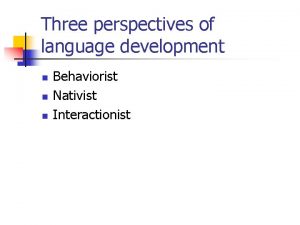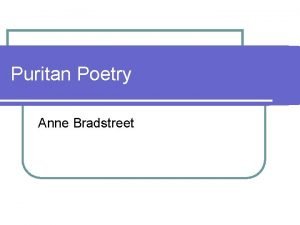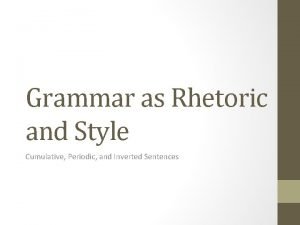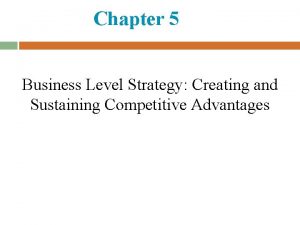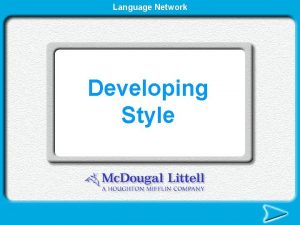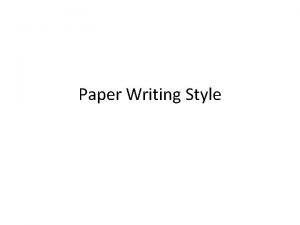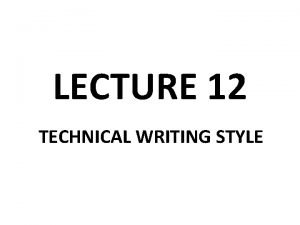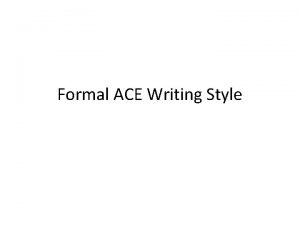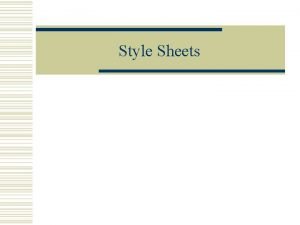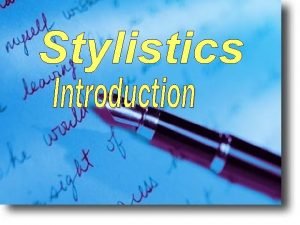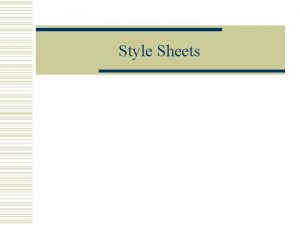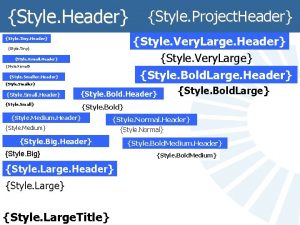Style Strategies for Your Writing Five Simple Strategies























- Slides: 23

Style Strategies for Your Writing Five Simple Strategies to Improve Sentence Variety Brought to you by the Center for Teaching and Learning 1

Why Bother Considering Style? l Engage your readers better l Sound more sophisticated l Control the pace of your writing for emphasis or de-emphasis l Gain rhetorical control of your message 2

The Brushstroke Concept l Just as visual artists learn different techniques with paints and brushes, writers need to employ different brushstrokes in their writing l Brushstrokes in writing link to grammatical structures: words, phrase, clauses and syntax (word order) 3

The Brushstrokes l Today I want to teach you five grammatical structures, or brushstrokes, to improve your writing ¡Powerful verbs ¡Participial phrases ¡Absolute phrases ¡Appositive phrases ¡Adjectives shifted out of order 4

Analyze Your Verbs l Try to rid your writing of forms of “to be. ” ¡Am ¡Is ¡Are ¡Was ¡Were ¡Being ¡Been 5

Consider Revising Conjugations of “To Be” l The first step I follow when I revise is to eliminate “to be” verbs as much as possible. l Sometimes I can simply tighten a verb phrase: ¡She was beginning to play a game. ¡She began playing the game. 6

Revising “To Be” cont. . . l Also, I might add some action rather than to state something outright. ¡He was a cheater every time he played games. ¡He cheated at every game he played. ¡He hid cards under the table during the game. 7

Last Word on “To Be” l When you write “something is something, ” you aren’t saying much. l “Tommy is a thief” provides no evidence of Tommy’s thieving. l Revise to “Tommy steals old ladies’ purses. ” 8

Participial Phrases l Participial phrases add descriptions to nouns and pronouns in your writing because they function as adjectives even though they resemble actions. l Let’s look at a couple of examples. 9

Participial Phrase Example l Tommy cheats at every board game he plays. l Cheating at every board game he plays, Tommy rarely loses to anyone. ¡(The participial phrase is underlined. ) 10

Participial Phrase Cont. l Here’s one more example: l Julia avoids playing games with Tommy. l Julia, avoiding games with Tommy, seeks other people to play with. ¡Notice how the participial phrase becomes the focus of the sentence when it interrupts the subject, Julia, and the verb, seeks. 11

Absolute Phrases l The absolute construction resembles the participial phrase l It includes a noun (person, place, thing, or idea) and a participle (a word that looks like an action ending in –ed or –ing in most cases, but a participle is actually an adjective describing a noun). l Let’s look at an example together. 12

Absolute Phrase Example l Julia enjoys intellectually stimulating games. l Intellect stimulated, Julia finds a partner for playing chess. l Mind racing, Julia finds an outlet for her overactive intellect in stimulating games. 13

Appositive Phrases l An appositive phrase adds details to other nouns. l The difference between an appositive phrase and a participial phrase is that an appositive also functions as a noun; therefore, an appositive phrase frequently begins with “a, an, or the. ” l Let’s look at some examples. 14

Appositive Phrases Cont. . . l Tommy still cheats at board games. l Tommy, a cheat at board games, can never find anyone who wants to play with him anymore. 15

Appositive Phrases Cont. . . l Julia needs an outlet for her overstimulated intellect. l An exceptionally bright student, Julia seeks an outlet through board games for her over-stimulated intellect. 16

Adjectives Shifted Out of Order l Adjectives, the most common form of description for beginning writers, describe nouns and pronouns. Two other brushstrokes—participial phrases and absolutes—function as adjectives, though in form they differ. l We’re going to look an adjectives from a fresh perspective by changing the order of their appearance in a sentence. 17

Adjectives Shifted Cont. . . l In English, adjectives usually come before nouns; for example, we would most likely write: The exciting and complicated game made for a fun evening. l If we shift the adjectives out of order, we draw attention to the adjectives and slow the pace of the sentence: The game, exciting and complicated, made for a fun evening. 18

Adjectives Shifted cont. . . l Let’s look at another example. l A sharp, apt contender, Julia often wins the games she plays. l Julie, sharp and apt, often wins the games she plays. l What are the differences in meaning between the first and second sentences? What is being emphasized in both? 19

Punctuation Alert l Be sure to pay attention to comma usage when employing the brushstrokes. l When using an introductory element, be sure to set it off with a comma. l If you are interrupting a sentence, as adjectives shifted out of order will inherently do, remember to set off the interruption with commas. 20

Last Word on Brushstrokes l I hope you have learned a range of possibilities in your writing. These five basic brushstrokes can help layer your writing with vivid description and enhance your writing style. l As with any technique, overuse can kill the variety you looked for to begin with, so use discretion when applying your new brushstrokes to your next assignment. 21

Sources l If you’re interested in the brushstroke approach to writing, grammar, and style, see Harry Nolen’s book Image Grammar. It is the primary source for this presentation. 22

More Questions or Concerns? l Please come visit the CTL and speak with a tutor. l Are you an online student? Well, you’re in luck. Any of our tutors can provide online services to help you learn how to improve your writing. Just schedule an online appointment. l 217 -206 -6503 l ctl@uis. edu 23
 These beauteous forms
These beauteous forms Five of five
Five of five Five elements and five senses
Five elements and five senses Dew the sovereign flower and drown the weeds
Dew the sovereign flower and drown the weeds Give us your hungry your tired your poor
Give us your hungry your tired your poor Modified letter style
Modified letter style Formal and informal word
Formal and informal word Formal vs casual tone
Formal vs casual tone Referential vs expressive style
Referential vs expressive style Puritan plain style poem examples
Puritan plain style poem examples Periodic cumulative and inverted sentences
Periodic cumulative and inverted sentences 5 generic business strategies
5 generic business strategies Growing and internationalizing the entrepreneurial firm
Growing and internationalizing the entrepreneurial firm Five business level strategies
Five business level strategies Generic competitive strategies examples
Generic competitive strategies examples Porter's five generic strategies
Porter's five generic strategies Five strategies
Five strategies Supplier power.
Supplier power. Domestic market extension concept
Domestic market extension concept Kontinuitetshantering
Kontinuitetshantering Typiska novell drag
Typiska novell drag Tack för att ni lyssnade bild
Tack för att ni lyssnade bild Returpilarna
Returpilarna Varför kallas perioden 1918-1939 för mellankrigstiden?
Varför kallas perioden 1918-1939 för mellankrigstiden?








